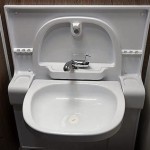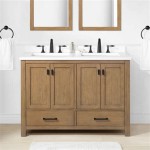12 By 17 Undermount Bathroom Sink: A Detailed Overview
The 12 by 17 undermount bathroom sink presents a practical and aesthetically pleasing solution for various bathroom configurations. Its dimensions position it as a mid-sized option, striking a balance between providing adequate basin space and minimizing countertop footprint. This article will explore the key characteristics, benefits, considerations, and installation aspects of 12 by 17 undermount bathroom sinks, providing a comprehensive understanding for homeowners, contractors, and designers alike.
Understanding the Undermount Sink Design
The defining feature of an undermount sink is its installation method. Unlike drop-in or vessel sinks, an undermount sink is mounted beneath the countertop. This creates a seamless transition from the countertop surface to the sink basin, eliminating the lip or rim that is characteristic of other sink types. This design choice offers several advantages, including ease of cleaning, enhanced aesthetics, and a modern, streamlined appearance.
The absence of a rim around the sink allows for effortless wiping of spills and debris directly into the basin, preventing the accumulation of dirt and grime. Furthermore, the clean lines of an undermount sink contribute to a minimalist and contemporary bathroom design. The countertop material extends uninterrupted to the edge of the sink opening, showcasing the material and creating a more visually appealing surface.
Undermount installation requires a solid surface countertop material, such as granite, quartz, marble, or solid surface composites. Laminate countertops are generally not suitable for undermount sinks due to their vulnerability to water damage at the exposed edges. The countertop must be precisely cut to match the sink's dimensions, ensuring a secure and watertight fit.
Key Benefits of a 12 By 17 Undermount Sink
The 12 by 17 undermount sink offers a specific set of benefits that cater to particular bathroom needs and design preferences. Its size is often ideal for smaller bathrooms or powder rooms where space is limited, while still providing sufficient basin area for everyday use.
First, the size is a sweet spot. A 12x17 inch sink works great for smaller bathrooms where space is a premium but you still want a decent sized wash basin. A smaller sink might feel too cramped, while a larger sink might overwhelm a small countertop.
Second, the undermount design itself offers cleaning advantages. Counter cleaning is much easier when you can simply wipe spills and crumbs, directly into the sink. No longer will you have to try and get cleaning rags, or sponges, into all the little areas around the edge of the sink.
Third, there is an aesthetic advantage. As stated before, the clean lines and smooth transition of an undermount sink enhance the overall look of the bathroom. The uninterrupted countertop surface showcases the material and contributes to a more sophisticated and modern design.
Finally, considering the 12x17 dimensions specifically can allow for greater flexibility in countertop selection and layout. It allows you to create more space for other bathroom fixtures, such as faucets and soap dispensers. This can be especially useful in small bathrooms where every inch of space counts. It can also allow, in some cases, for slightly smaller vanities, which can be a big space saver.
Factors to Consider Before Purchasing
Before committing to a 12 by 17 undermount bathroom sink, several factors should be carefully considered to ensure compatibility with the existing bathroom layout and personal preferences. These factors include material selection, faucet compatibility, installation requirements, and maintenance considerations.
Material Selection: Undermount sinks are available in a variety of materials, each with its own characteristics and aesthetic appeal. Common materials include vitreous china, fireclay, stainless steel, and cast iron. Vitreous china is a popular choice due to its durability, stain resistance, and affordability. Fireclay offers a similar aesthetic but is typically more expensive and heavier. Stainless steel provides a modern and durable option that is resistant to rust and corrosion. Cast iron sinks are known for their durability and heat retention, but they are also the heaviest and most expensive option.
Faucet Compatibility: The choice of faucet should complement the style and dimensions of the sink. Consider the number of faucet holes required and the overall height and reach of the faucet spout. Undermount sinks typically require countertop-mounted faucets, allowing for a wide range of design options. Ensure that the faucet's design and finish coordinate with the sink and other bathroom fixtures.
Installation Requirements: Installation of an undermount sink requires precise countertop cutting and secure mounting. It is generally recommended to hire a professional plumber or contractor to ensure proper installation and prevent leaks or damage. The countertop must be properly sealed around the sink opening to prevent water damage. The sink must be securely attached to the countertop using clips or epoxy adhesive, depending on the sink's material and weight.
Maintenance Considerations: Different sink materials require different maintenance routines. Vitreous china and fireclay are relatively easy to clean with mild soap and water. Stainless steel sinks may require specialized cleaners to prevent water spots and scratches. Cast iron sinks with an enamel coating should be cleaned with non-abrasive cleaners to avoid damaging the finish. Regular cleaning and maintenance will help to prolong the life and beauty of the sink.
Choosing the Right Material for Your 12 By 17 Undermount Sink
The material of your 12 by 17 undermount sink significantly impacts its durability, aesthetics, and maintenance requirements. Each material offers a unique set of advantages and disadvantages, influencing the overall cost and performance of the sink.
Vitreous China: This is a common and affordable option. Vitreous china is made from porcelain clay fired at high temperatures, resulting in a durable and non-porous surface. It is resistant to stains, scratches, and chipping, making it a suitable choice for everyday use. Vitreous china sinks are available in a wide range of colors and styles, offering versatility in design choices. Their drawback is that their aesthetic can feel somewhat basic, or commonplace.
Fireclay: Fireclay sinks are similar to vitreous china but are made from a denser clay that is fired at even higher temperatures. This results in a stronger and more durable sink that is less prone to cracking or chipping. Fireclay sinks often have a thicker and more substantial feel than vitreous china sinks. While generally more expensive than vitreous china, they offer a more premium look and feel.
Stainless Steel: Stainless steel sinks are known for their modern and durable design. They are resistant to rust, corrosion, and staining, making them a practical choice for high-use bathrooms. Stainless steel sinks are also relatively lightweight, which can simplify installation. However, they can be prone to water spots and scratches, requiring regular cleaning with specialized cleaners. A brushed stainless steel finish can help to minimize the appearance of scratches.
Cast Iron: Cast iron sinks are made from molten iron poured into a mold and then coated with a thick layer of enamel. This results in a heavy and durable sink that is resistant to heat and impact. Cast iron sinks are available in a variety of colors and styles, including classic and contemporary designs. However, they are the heaviest and most expensive option, requiring a sturdy countertop and professional installation. The enamel coating can also be susceptible to chipping or cracking if exposed to sharp objects or harsh chemicals. A benefit of cast iron is its ability to retain heat, which can allow for warmer water to keep its heat over longer periods.
Step-by-Step Installation Guide (General Overview)
While professional installation is recommended, understanding the basic steps involved in installing a 12 by 17 undermount bathroom sink can provide valuable insight into the process. This guide provides a general overview of the installation steps, but it is important to consult the sink manufacturer's instructions for specific details and recommendations.
Step 1: Countertop Preparation: The countertop must be prepared for undermount sink installation. This involves cutting the opening in the countertop according to the sink manufacturer's specifications. This usually requires a template to accurately mark the cut line. It is critical to ensure a precise and clean cut to prevent gaps or leaks. As previously mentioned, solid surface countertops are necessary for this installation method. Laminate countertops are not.
Step 2: Sink Placement and Alignment: Carefully position the sink beneath the countertop opening, ensuring that it is properly aligned and centered. Use clamps or supports to hold the sink in place while applying adhesive or sealant.
Step 3: Securing the Sink: Apply a bead of silicone sealant or epoxy adhesive to the rim of the sink, where it will contact the countertop. Follow the manufacturer's instructions for the recommended type and amount of adhesive. Press the sink firmly against the countertop, ensuring a tight and even seal. Use clips or mounting brackets to further secure the sink to the countertop. These clips are typically attached to the underside of the countertop and tightened to hold the sink in place. Follow the manufacturer's instructions for the proper placement and tightening of the clips. Most undermount sinks include sink mounting brackets that keep everything in place. Be sure your undermount sink comes with brackets, or that you locate some brackets for purchase to complete the project.
Step 4: Plumbing Connections: Connect the drain assembly to the sink, ensuring a watertight seal. Connect the water supply lines to the faucet, following the manufacturer's instructions. Verify that all plumbing connections are secure and leak-free. Often, flexible connectors, like PEX tubing, are connected at this stage to allow for slight variances in plumbing, and ease of installation, especially later on if repairs are needed.
Step 5: Final Inspection and Cleanup: Inspect the installation for any gaps or leaks. Clean up any excess sealant or adhesive. Allow the sealant to cure completely before using the sink.
Cost Considerations
The cost of a 12 by 17 undermount bathroom sink can vary depending on the material, brand, and features. Vitreous china sinks are typically the most affordable, ranging from $50 to $200. Stainless steel sinks range from $100 to $300, depending on the gauge and finish. Fireclay sinks range from $200 to $500, while cast iron sinks can range from $300 to $800 or more.
Installation costs can also vary depending on the complexity of the project and the rates of local plumbers or contractors. Professional installation can range from $100 to $300 or more, depending on the need for plumbing modifications or countertop alterations. It is advisable to obtain multiple quotes from qualified professionals before proceeding with the installation.
In addition to the sink and installation costs, consider the cost of additional components, such as faucets, drains, and mounting hardware. Faucets can range from $50 to $500 or more, depending on the style, finish, and features. Drains and mounting hardware typically cost between $20 and $50. The total cost of installing a 12 by 17 undermount bathroom sink can range from $200 to $1500 or more, depending on the materials chosen and the complexity of the installation. Careful planning and budgeting are essential to ensure a successful and cost-effective project.

Ruvati 17 X 12 Inch Undermount Bathroom Vanity Sink White Rectangular Porcelain Ceramic With Overflow

Zuhne Undermount Bathroom Sink With Overflow White Vitreous Enamel O

Lt643 01 Dartmouth 17 1 4 X 12 7 8 Oval Undermount Bathroom Sink In Cotton White Af Supply

Dartmouth 17 1 4 X 12 7 8 Oval Undermount Bathroom Sink Cotton White Lt643 01 Com

Ruvati 17 In Rectangular Undermount Vanity Bathroom Porcelain Ceramic With Overflow White Rvb0718 The Home Depot

Dartmouth 17 1 4 X 12 7 8 Oval Undermount Bathroom Sink Cotton White Lt643 01 Com

Just Manufacturing Uoir 1521 A Oval Undermount Sink Bowl 17 1 2 X 12

Ruvati 17 In Rectangular Undermount Vanity Bathroom Porcelain Ceramic With Overflow White Rvb0718 The Home Depot

Dartmouth 17 1 4 X 12 7 8 Oval Undermount Bathroom Sink Cotton White Lt643 01 Com
How To Measure A Vanity Sink Bathroom Dimensions Standard Size Vevano







